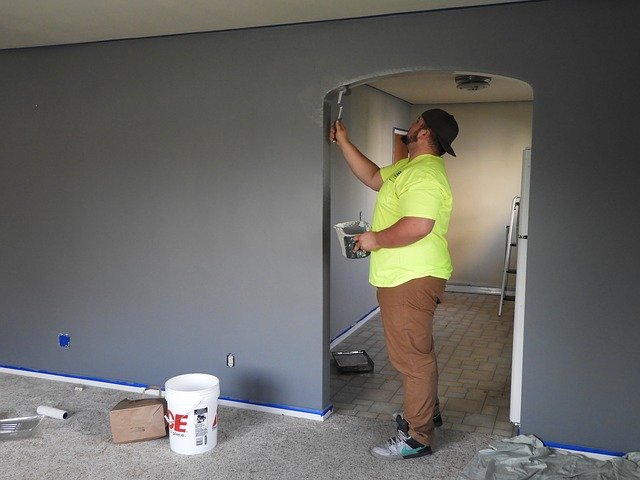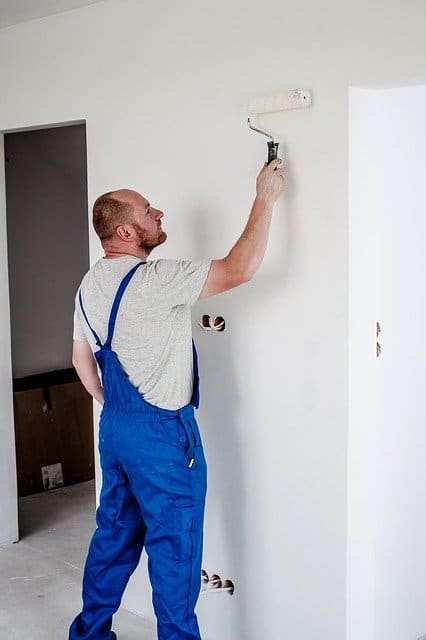
An interior paint job should leave your walls looking fresh, clean and beautiful. Unfortunately, not every painter takes the time to make walls perfect.
Signs of a bad interior paint job include stains, old paint showing through, lack of preparation, drip marks, paint coming off, tape being left on walls, inconsistent looking paint and paint in places it shouldn’t be. These painting flaws are caused by a lack of effort or experience by the painter.
Some of the signs of a bad interior paint job can be hard to notice. Read this article to learn more about how to spot the signs of a bad interior paint job.
No Room Preparation
A painter might ask you to remove all furniture from a room, or at least move furniture away from the walls. Then the painter should supply drop cloths and other protective materials for the room. A professional painter puts protective painter’s tape on items that aren’t removable, such as:
- Trim
- Window sills
- Vent covers
A professional painter covers windows with plastic and seals them from paint with tape. Wall outlets and light fixtures should be removed or taped over before painting. Anywhere that paint should not land needs to be protected.
If you see paint in places that should not have it, the painter may have done a poor job of protecting the room. Getting paint on items that should have been protected calls the entire paint job into question.
No Wall Preparation
The more time spent preparing a surface, the more likely the paint will stick and stay there for decades. Depending on the condition of the wall, preparation can take up to 90-percent of a paint job. Paint preparation consists of a few tasks, including:
- Repairing dents, cracks and holes
- Deglossing glossy paint
- Removing flaking or bubbling paint
- Washing the wall to remove dust and stains
A professional painter should bring all the supplies and tools for paint preparation. If a wall is in good shape, all that might be needed for prep could be washing and drying.
If there is not enough preparation, paint could have a difficult time sticking to the wall. You could notice that paint flakes off if you touch it or has bubbles that break and expose the old paint or bare wall.
Visible Stains
If there is a stain on the wall, it needs to be sealed with up to two coats of primer so it won’t bleed through the new paint. A sloppy painter could be tempted to skip sealing a stain to save time, effort and money.
The Old Paint Is Visible
If you want to paint a lighter color over a darker color, it takes more work to get the new paint looking its best. Primer is the best solution to help hide the old paint color because it is cheaper than paint and gives you a fresh start with the wall. The other solution is to use multiple coats of paint, but it could take three or more coats, which wastes time and money.
A bad painter might apply too few coats of paint or not want to add a primer coat, leaving the old paint showing through. This is unacceptable for a professional paint job.
The texture on a wall can cause a roller to leave small dots of the old paint showing. A professional painter takes the time to go over the wall and make sure that none of the old paint is visible with touch-ups or an entire new coat.
Drip Marks
If a painter applies too much paint to a wall or uses the wrong type of brush, paint drips down the wall and leaves a bump. This makes your walls look bad and should not be tolerated from a professional paint job.
A good painter knows how to apply the correct amount of paint so it doesn’t drip. They are also vigilant and clean up any drips that happen by accident before they dry onto the wall.
Chalky Paint
If you can wipe paint dust off the wall with your finger, it is chalky paint. This can happen if a painter uses too much thinner in their paint.
Chalky paint is also a result of sun exposure. In an older paint job that is exposed to the sun through a window, it is not a sign of a bad job.
Wrinkled Paint
If oil paint is applied in too cold of a room, below 50-degrees Fahrenheit, it could have a wrinkled appearance when it dries. A professional painter should know to heat a room to give an oil-based paint the best chance of looking good.
Alligatoring
Paint that cracks in a pattern that resembles an alligator’s skin is called alligatoring. This paint flaw is caused when the painter doesn’t wait long enough between coats of paint.
Oil-based paints need at least 24 hours of drying before applying a second coat. Latex paints can have a second coat applied after four to six hours.
Alligatoring can be a sign of natural aging in oil-based paints. If your wall hasn’t been painted in many years, alligatoring is not a sign of a bad paint job.
Patchy Paint
In a bad paint job, you might notice darker patches of paint with see-through areas. This comes from using the wrong amount of paint and not completing enough brush strokes to spread the paint evenly. This is a sign that the painter rushed through their work.
Too Many Coats
Two coats of paint are usually sufficient for painting over an already painted wall. You can’t really use too many layers of paint, but more than three coats are excessive unless you have special circumstances that require more paint.
If a painter uses low-quality brushes or bad painting techniques, they might need to paint extra layers. A dishonest painter might add an extra coat of paint to boost their hours. This ends up costing you more for the extra paint and labor.
Peeling or Blistering
None of the new paint should come off after drying. Peeling or blistering paint is a sign that the wall was still wet from being washed when the painting started. This may happen because the painter was in a hurry and didn’t wait for the wall to dry after washing it.
Not All Walls Look The Same
If you notice that two walls that should be the same color look slightly different, this is a sign of a bad paint job. These slight color changes can happen if a painter uses one can of paint on one wall, runs out of paint from the can, then uses a new can of paint on another wall.
Even though two cans of paint say they are the same color, they are mixed individually and will have slight differences. A professional painter always mixes their paint cans together to ensure uniform color throughout the paint job.
Pieces Of Painters Tape Left Behind
If a painter leaves painter’s tape in place too long, it can stick too strong and small pieces of tape break off and are difficult to remove. A professional painter removes painter’s tape before it gets too stuck on, or they take the time to remove the small pieces that didn’t come off easily.
If a painter removes their tape before the paint dries, it can tear away some of the fresh paint. A sloppy painter leaves their lines looking jagged, while a pro painter takes the time to fix any mistakes that happen when removing tape.
Wrong Paint For The Room

A professional painter will have experience guiding you to select the best paints for different areas of your home. They can also help you choose colors, but that decision is mostly up to the homeowner. A pro painter might help you pick a color by painting swatches on your walls to see how the paint will look under real-life conditions.
Certain finishes of paint are better suited to different rooms in the house. Areas where a painter should use a particular finish include:
- Entryways need a semi-gloss finish so walls can be washed.
- Living rooms, dining rooms and bedrooms need a matte or eggshell finish, which has more color vibrancy and looks smoother.
- Bathrooms and kitchens should have a semi-gloss or glossy finish that stands up to more moisture.
A bad paint job could consist of using all the same paint throughout the house or using the wrong finish in the wrong area. A painter that doesn’t offer help selecting paint colors and finishes might end up doing a bad interior paint job.
How To Deal With A Bad Painter
Most people don’t like to be watched while working and won’t like being told how to do their job. To check on a painter while they work, offer them a snack or a drink, but don’t hover in their work area. If you have concerns about their work, politely ask them to explain what they are doing, don’t accuse them of doing it wrong before you get an explanation.
If you notice signs of a bad interior paint job after the work is done, take pictures of all of the mistakes you find. Call the painter and ask them to come to fix the problems or refund your money. Be polite and friendly, and the painter will most likely want to repair their work.
If the painter is hostile and refuses to help, it is best to end the relationship and find another painter to fix the bad paint job. You can leave honest reviews online for the painter or make complaints with a consumer protection association.

